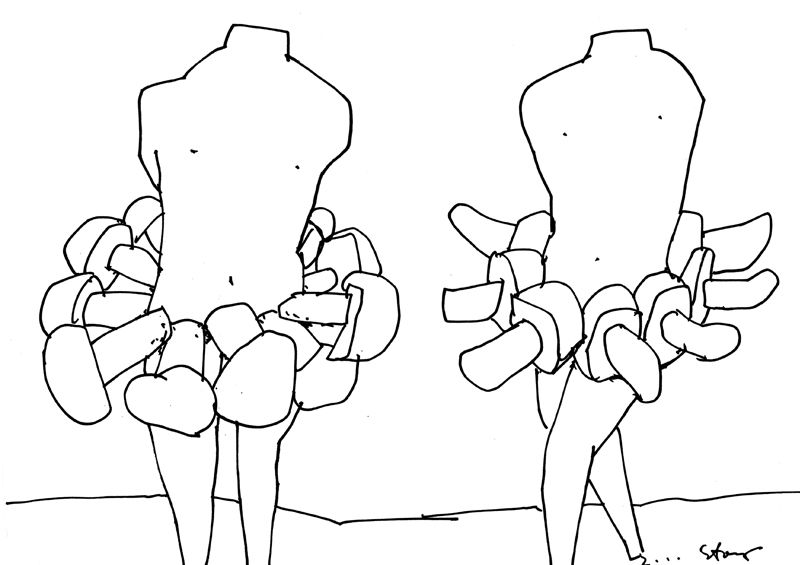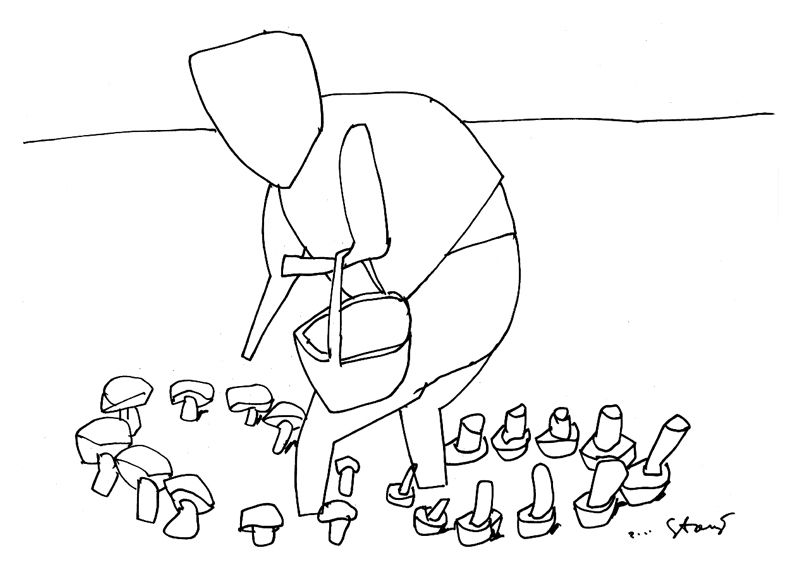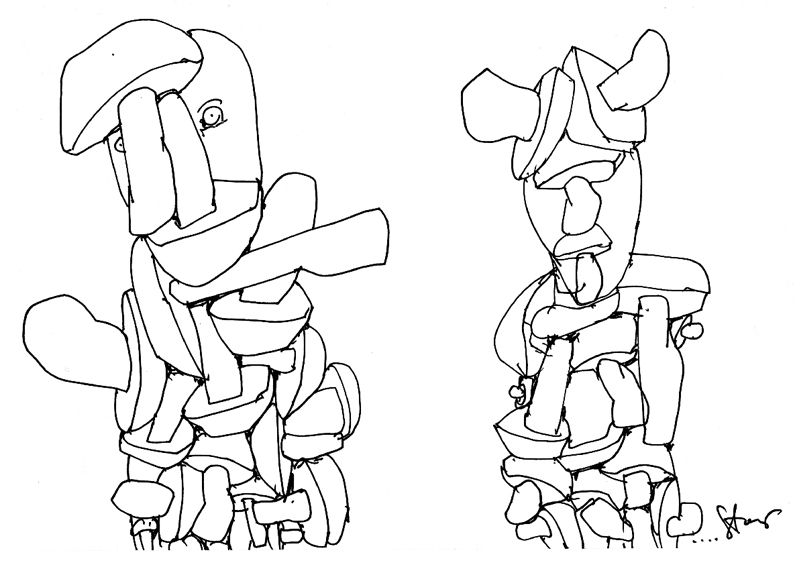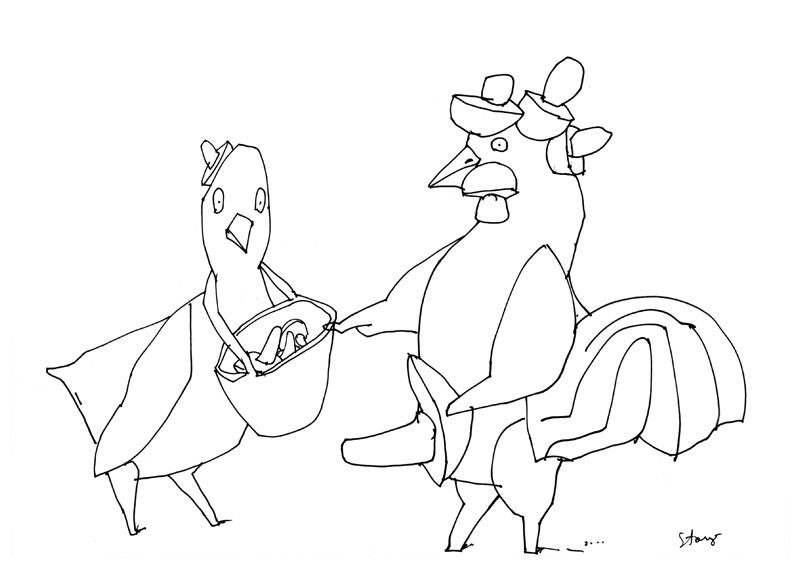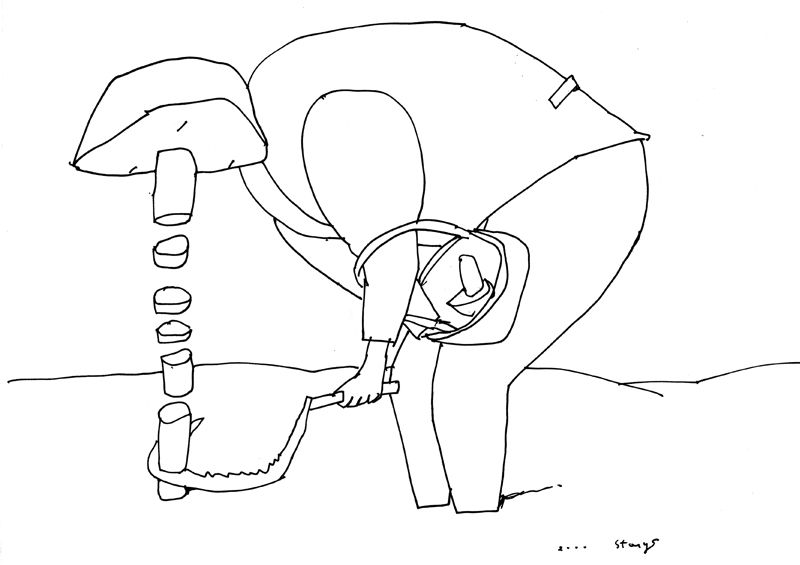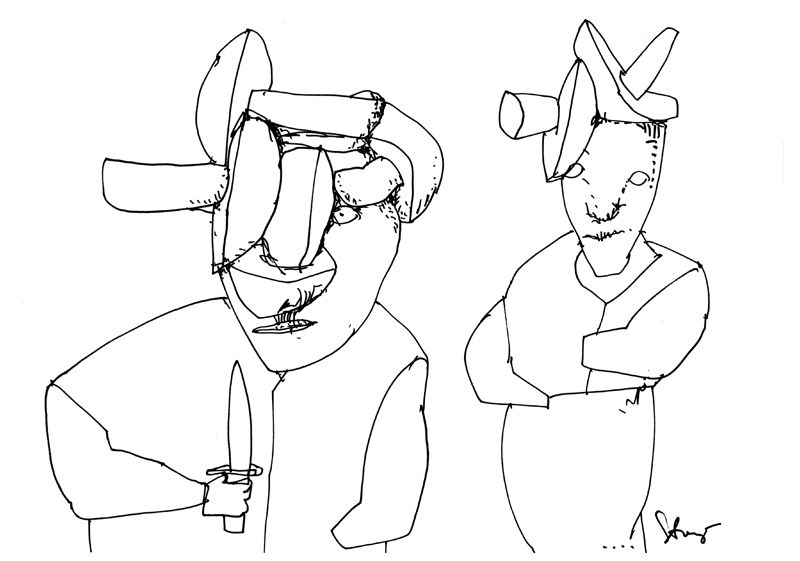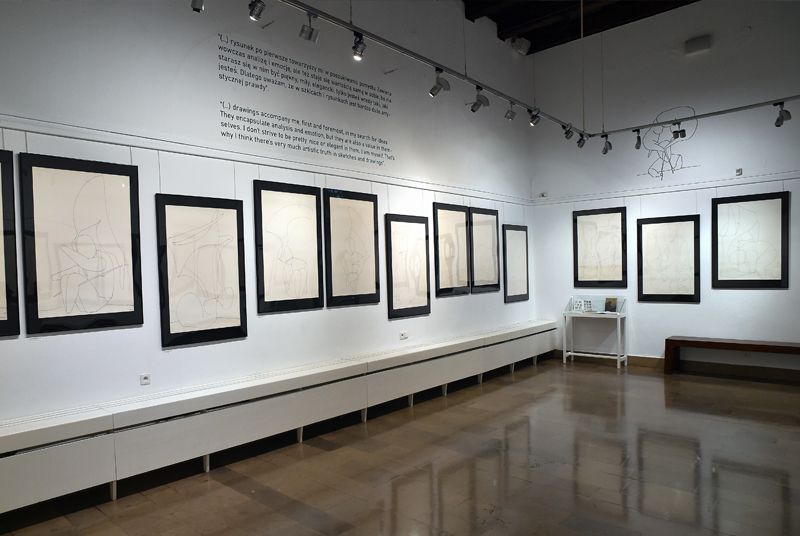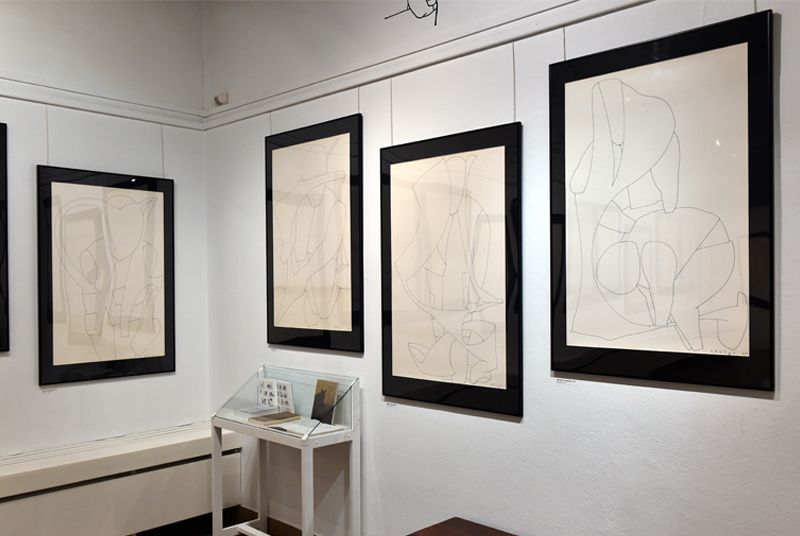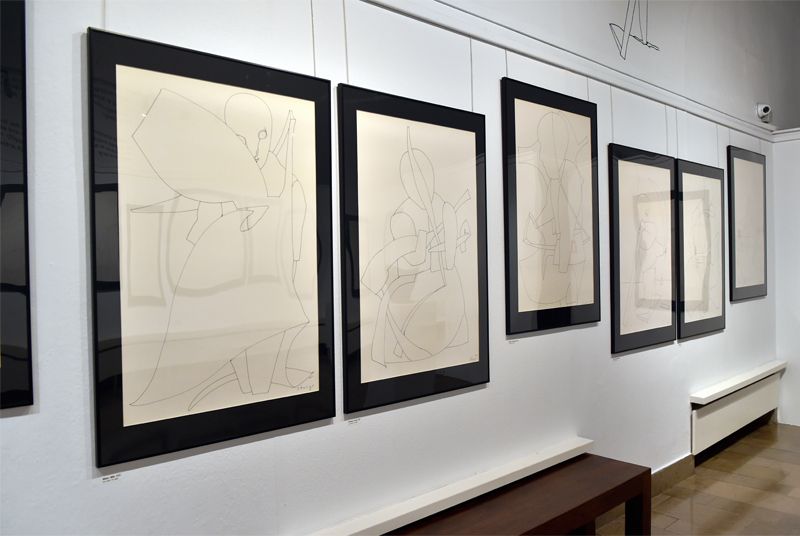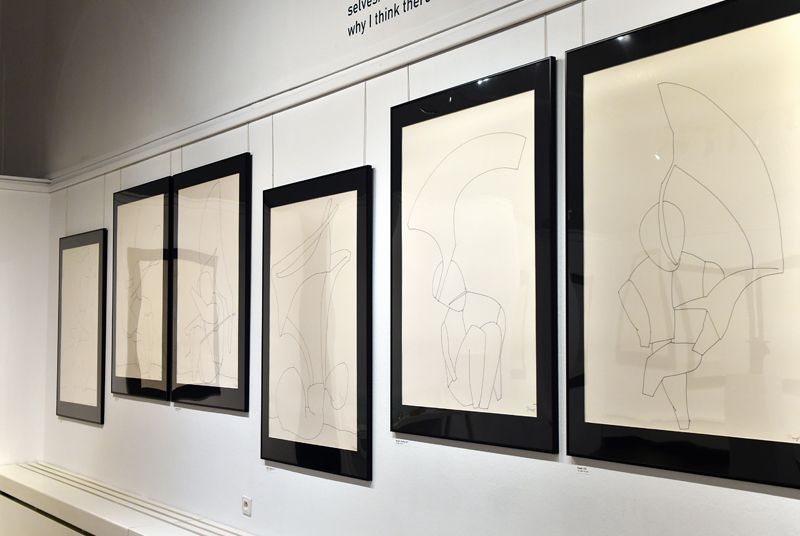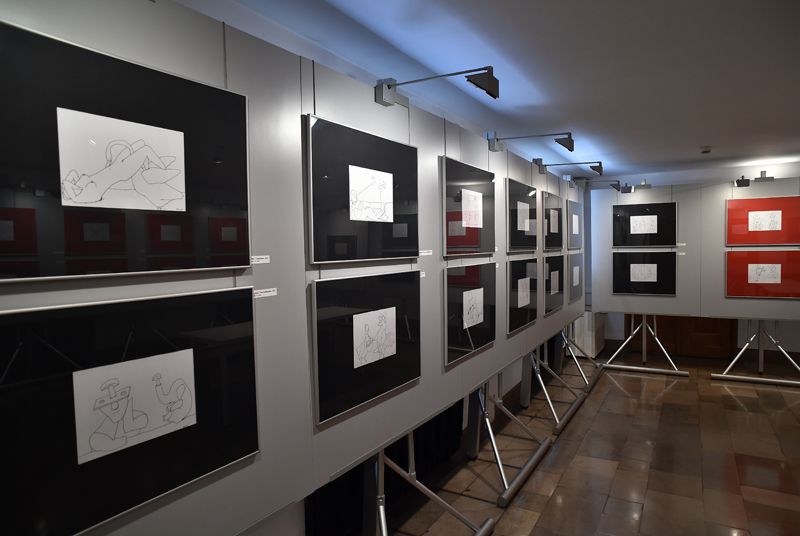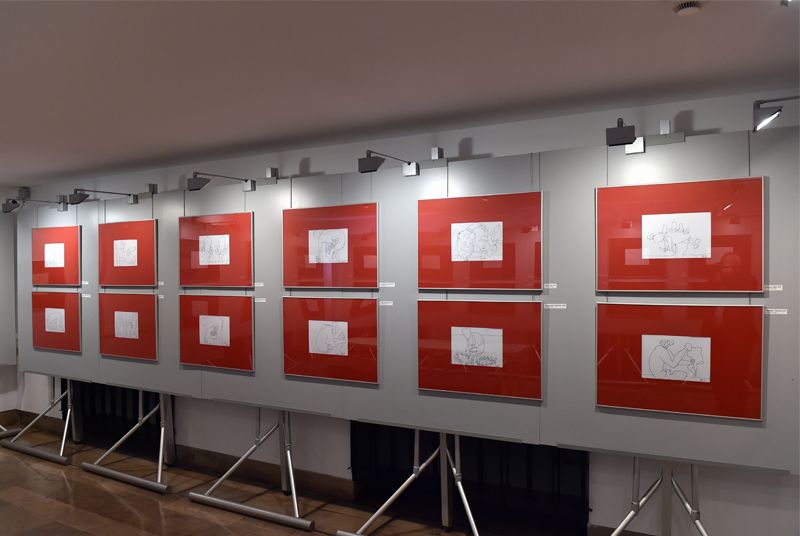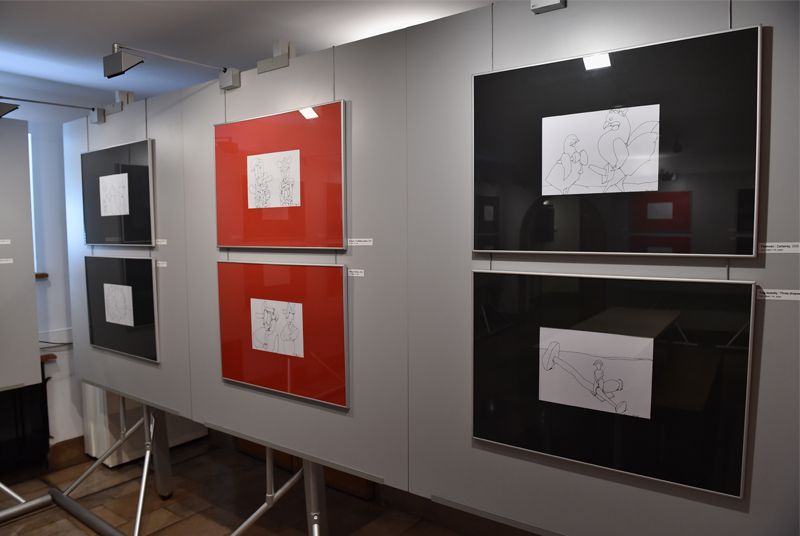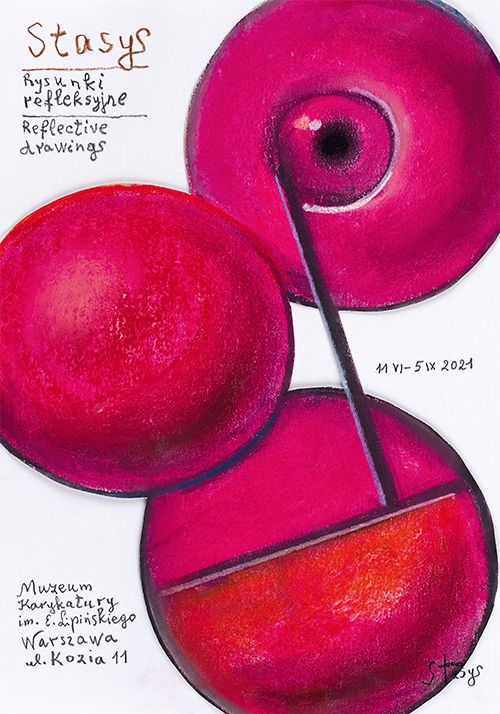
STASYS
Reflective Drawings
11 June – 12 September 2021
The exhibition entitled “Stasys – Reflective Drawings” presents selected works by Stasys Eidrigevičius a graphic artist, painter, author of pastels and posters, whose works have been shown at numerous individual exhibitions in Poland and worldwide.
Two cycles of ink drawings from the Artist’s private collection. Both were created in the year 2000 and have not yet been published or shown in public. The first of them, of reflective character, comprises 28 works which depict humans engaged in various activities – a theme which the Artist used as a pretext for visual representations of abstract ideas and his own emotional states. This unique cycle on large-format cards, exceptional also in Stasys’ own output, is characterised by simple form and economical language of expression. The prevailing thin lines create a suitable atmosphere; they direct and construct, provide a framework, sensitise the viewer, and give shape to what had its origins in the Artist’s mind.
The second cycle, formally close to the first one and created using the same technique, consists of 37 humorous pieces on erotic subjects, revolving around the motif of mushroom-picking. This series, combining a large dose of humour with frivolous elements, shows us another, more ribald side of Statys’ art and provides a counterbalance to the first, reflective cycle. ‘Mushroom Picking’ centres on flirtation, courtship, and seduction in both the human and animal worlds. All those amorous raptures and conquests are symbolically depicted in this series of drawings, in which the private parts are characteristically represented in the form of mushrooms, which enhances the cycle’s playful undertones.
The exhibition demonstrate that Stasys, as a versatile artist, not only expresses himself through various disciplines of art, but also comments on serious and important subjects, as evident from his reflective-existential drawings, and makes daring ventures into lighter, humorous repertoire. Notably, however, Stasys’ approach as a humorist is a contemplative one, and it is from this perspective that we should look at his cartoons: not as a form of sheer entertainment, but rather as a peculiar continuation of his reflections focusing on humans and the world around us.
Stasys Eidrigevičius
A graphic artist, painter, author of pastels, born on 24th July 1949 in Mediniškiai, Lithuania. He works with graphic techniques, creates drawings, illustrations, bookplates, sculptures, paintings, and photos. He designs posters, covers, and stage sets. He is also active in performance and installation art. He studied leather design at the S. Žukas College of Applied Arts in Kaunas (1964–1968), and painting at the State Art Institute of the Soviet Socialist Republic of Lithuania in Vilnius (1968–1973), where he also took part in graphic classes. He came to Poland in 1975 and in 1980 obtained a permanent residence permit, settling in Warsaw.
In his works he combines many disciplines, which frequently coexist and interpenetrate. In 1970–1980 he mainly focused on bookplates, hyperrealist paintings, miniatures created in watercolour, gouache, and distemper techniques, as well as his first book illustrations. He made his debut as a graphic artist in the Literatūra ir means weekly. In later years his drawings and cover designs were printed by numerous Polish magazines, including Literatura, Polityka, Radar, Filipinka, Nowa Wieś, Pentliczek, Jazzi Magazine, Wileńskie Słowo, Europa, Charaktery, and Rzeczpospolita, as well as abroad in, among others, Kultūros Barai, New York Times, Book Review, The World Paper, Hemispheres, and Philadelphia Inquirer Magazine. In the 1980s he continued to illustrate books for many publishers in Poland (Polski Instytut Wydawniczy, Krajowa Agencja Wydawnicza, Polska Oficyna Wydawnicza BGW, Nasza Księgarnia) as well as abroad (Vaga and Vyturys in Lithuania, Viking in Great Britain, Bohem Press and Editions Nord-Süd in Switzerland, and Der Kinderbuchverlag in Germany). In the same decade he began to design posters. His numerous posters for the theatre, film, exhibitions, festivals, and other events have been commissioned by institutions in Poland, France, Spain, Denmark, Lithuania, the United States, and other countries. During his stay in Berlin in 1985, he took up pastel painting and drawing, which remain one of his main means of expression also today. His first masks were created in 1986 in Chicago. They take the form of pastel paintings and represent distorted, transformed human faces. Since the early 1990s he has staged paratheatrical performances, accompanying, among others, the openings of his exhibitions. In 1993 the Studio Theatre in Warsaw staged his first original spectacle entitled White Stag. His second play, Wooden Man, was produced in the same theatre in 2007. The early 90s saw his return (for some time) to oil painting, as represented by a cycle of 21 works with texts in various languages. In the same decade he was also very active as a sculptor, working mainly with wood and metal. Another project from that period is the installation cycle Sorrows, which consists of pastel faces as well as tree roots and branches. During his stay in France (2003), Stasys became acquainted with Fresson’s large-format photographic technique, which makes it possible to combine graphic effects with painting. Photography had been one of the artist’s passions from his earliest years. Still, it was after 2000 that his most interesting, arranged photos of staged scenes were created. In Paris he also made his first paper masks (2003–2004) which bring to mind the Japanese Nō theatre. In recent years, as well as creating new drawings, photos, and posters, Eidrigevičius has used the pastels more and more frequently.
Stasys rich and varied output has frequently been shown at individual exhibitions in Poland and worldwide, such as those held at the State Art Institute in Vilnius (Lithuania, 1970), the Łódź BWA (Bureau of Artistic Exhibitions, now the Municipal Art Gallery, Poland, 1975, 1985), the Toruń BWA (Poland, 1976), the Museum of Central Pomerania in Słupsk (Poland, 1977), the Critics’ Gallery in Warsaw (1979), the Art Workers’ Palace in Vilnius (Lithuania, 1979), Zapiecek Gallery in Warsaw (1981), the Théâtre Populaire Romand in La Chaux-de-Fonds (Switzerland, 1983), Arisdorf Gallery in Basel (Switzerland, 1984), Lothar Sperlich’s gallery in West Berlin (1984); the Tallin Gallery of Art (Estonia, 1985); Galleri Ängeln in Lund (Sweden, 1985), the Gdynia BWA (Poland, 1986); Northridge University Gallery in Los Angeles (USA, 1986), Konstfrämjandet Västra in Gothenburg (Sweden, 1987), NDA Gallery in Sapporo (Japan, 1987); the National Museum in Wrocław (Poland, 1988), Ginza Graphic Gallery in Tokyo (Japan, 1988, 1998); the Historical Museum of the City of Gdańsk and the Polish Cultural Centre in Gdańsk (Poland, 1989), Leipzig (Germany, 1989); Gallery Hesenhuis in Antwerp (Belgium, 1990); the Polish Cultural Institute in London (1990); the Museum of History of the City of Łódź (Poland, 1991); the Spicchi dell’Est art gallery in Rome (Italy, 1991); the Musée d’Art et d’Histoire in Saint-Denis (France, 1991), Studio Gallery in Warsaw (1992, 1994); the Museum of Contemporary Art in Radom (1992); Benassati Gallery in Modena (Italy, 1992); the Olsztyn BWA (Poland, 1993), Test Gallery in Warsaw (1993); Vilnius Contemporary Art Centre (1993); Eastwick Art Gallery in Chicago (USA, 1993); the Silesian Museum in Katowice (Poland, 1994); the Lawrence Wilson Art Gallery in Perth (Australia, 1995); Nord-Est Galerie in Paris (1995); Museo de la Estampa in Mexico City (1995); the National Museum in Gdańsk (Poland, 1996); Musée des Oudayas in Rabat (Morocco, 1996); Mikkeli Art Museum in Mikkeli (Finland, 1997); Musée des Beaux-Arts in Le Locle (Switzerland, 1997); the German Cultural Centre in Bangalore (India, 1998); Dansk Plakatmuseum in Aarhus (Denmark, 1999); the Palace of Art of the Kraków Society of Friends of Fine Arts and the ‘Sztuka’ Auction House Gallery in Cracow (1999); the National Museum of Lithuania in Vilnius (2000); Galeria 86 in Łódź (Poland, 2000); the Willy Brandt House in Berlin (2000); the Bet Ariela Cultural Center in Tel Aviv (Israel, 2000); Graphic Artists’ House ZPAF in Warsaw (2001); the Platan Gallery of Contemporary Art in Budapest (Hungary, 2001); the Nord-Est Galerie in Strasbourg (France, 2001); the Poster Museum in Warsaw (2002); the Lithuanian Museum of Art in Lemont (USA, 2002); the Institut Polonais de Paris (2003); the State Gallery of Art in Sopot (Poland, 2003); the Thomas Masters Gallery in Chicago (USA, 2004); the Poster Gallery in Tokushima (Japan, 2004); the Museum der Stadt in Güstrow (Germany, 2005); the Castle Gallery in Lublin (Poland, 2005); the Museo Explora in Rome (2006); the Western Art Museum in Riga (Latvia, 2006); Centre du Graphisme in Grenoble (France, 2007); SPAF Old Gallery in Warsaw (2007); the University of Michigan, Ann Arbor (USA, 2008); Les Célestins Théâtre in Lyon (France, 2009); the Podlasie Museum in Białystok (Poland, 2009); the Graphic Art and Poster Gallery in Warsaw (2010); the National Gallery of Art in Vilnius (2011); Centre for Theatre Practices in Gardzienice (Poland, 2011); the Lithuanian Centre in Warsaw (2012); Galerie Roi Doré in Paris (2012); Biblioteca Angelica in Rome (Italy, 2013); the Zamość BWA (Poland, 2013); Kunstkamera Meno Galerija in Vilnius (2014); Artemis Gallery in Cracow (2015); Trakai Island Castle (Lithuania, 2016); Płock Art Gallery (Poland, 2017); the Mark Rothko Art Centre in Daugavpils (Latvia, 207); the Adam Mickiewicz Museum of Literature in Warsaw (2018); the M.K. Čiurlionis National Art Museum in Kaunas (Lithuania, 2019); the Musashino Art University in Tokyo (2019); the Musée des beaux-arts in La Chaux-de-Fonds (Switzerland, 2019); La Galerie La Joie de Voir in Geneva (Switzerland, 2020); the European Economic and Social Committee EESC in Brussels (2020), and the ‘Wirydarz’ Art Gallery in Lublin (2020). His works have also been shown at numerous collective exhibitions in Poland and abroad.
Stasys Eidrigevičius’ numerous prestigious prizes and honourable mentions in Polish national and international competitions for book illustrations, small-scale graphic forms, bookplates, posters, and spatial forms include: the honorary medal of the 6th International Biennial Exhibition of Modern Exlibris in Malbork (Poland, 1973); the 3rd prize of the 16th Congresso Internacional de Ex-Libris in Lisbon (1976); the Biennial of Illustration Bratislava Golden Apples BIB ’79, BIB ’81, and BIB ’89 (Bratislava, 1979, 1981, 1989); the Bronze Medal of the Leipzig Book Fair (Germany, 1984); the Grand Prix of the 2nd International Competition for Children’s Book Illustration in Barcelona (1986); the 1st prize and audience award at the 2nd International Poster Salon in Paris (1988); the Gold Hugo at the Chicago International Film Festival (1987); the Silver Medal of the 2nd International Graphic Arts Exhibition in New York (1988); the Grand Prix of the 1st Belgrade International Biennial of Illustrations (1990); the Bronze Medal of the 13th International Poster Biennale in Warsaw (1990); the Grand Prix of BIB ’91 Biennial of Illustration Bratislava (1991); the Gold Medal of Art Expo in Tokyo (1994); the Bronze Medal and special award of the 14th Polish Poster Biennial in Katowice (Poland, 1995); the Gold Medal of the 16th Polish Poster Biennial in Katowice (1999), as well as the Bronze Medal of the International Poster Triennial in Toyama (Japan, 2009).
In 1993, Stasys received the ‘Passport’ Award of the Polityka weekly; in 2000 – the Order of the Lithuanian Grand Duke Gediminas (a Lithuanian presidential award); in 2001 – the Lithuanian National Culture and Art Prize (Nacionalinė kultūros ir meno premija); in 2010 – the Silver Medal for Merit to Culture – Gloria Artis; in 2019 – the Commander’s Cross of the Order of Merit of the Republic of Poland, and in the same year the Badge of Honour ‘Carry your Light and Believe’, granted by the Lithuanian Ministry of Culture; In 2009 the Vilnius Academy of Arts bestowed on him its honorary doctorate. Since 2012 he has been an honorary member of the Russian Academy of Arts.
Eidrigevičius’ works can be found in numerous museums and galleries worldwide, for instance: in the National Museums in Warsaw, Cracow, Poznań and Szczecin, the Poster Museum in Warsaw, ‘Zachęta’ National Gallery of Art in Warsaw, the National Museum of Lithuania in Vilnius, the National Museum in Prague, the Vatican Museums, the Musée des Arts Décoratifs in Paris, the British Museum in London, the Stedelijk Museum in Amsterdam, the Dansk Plakatmuseum in Copenhagen, the Museum of Modern Art in New York, the National Library in Washington, the Creation Gallery in Tokyo, the Museum of Modern Art in Toyama, as well as in private collections.
Piotr Kułak
Exhibition curator and catalogue editor: Piotr Kułak
Catalogue graphic design: Paweł Osial
Poster design: Stasys Eidrigevičius
Drawings of reflective character
-
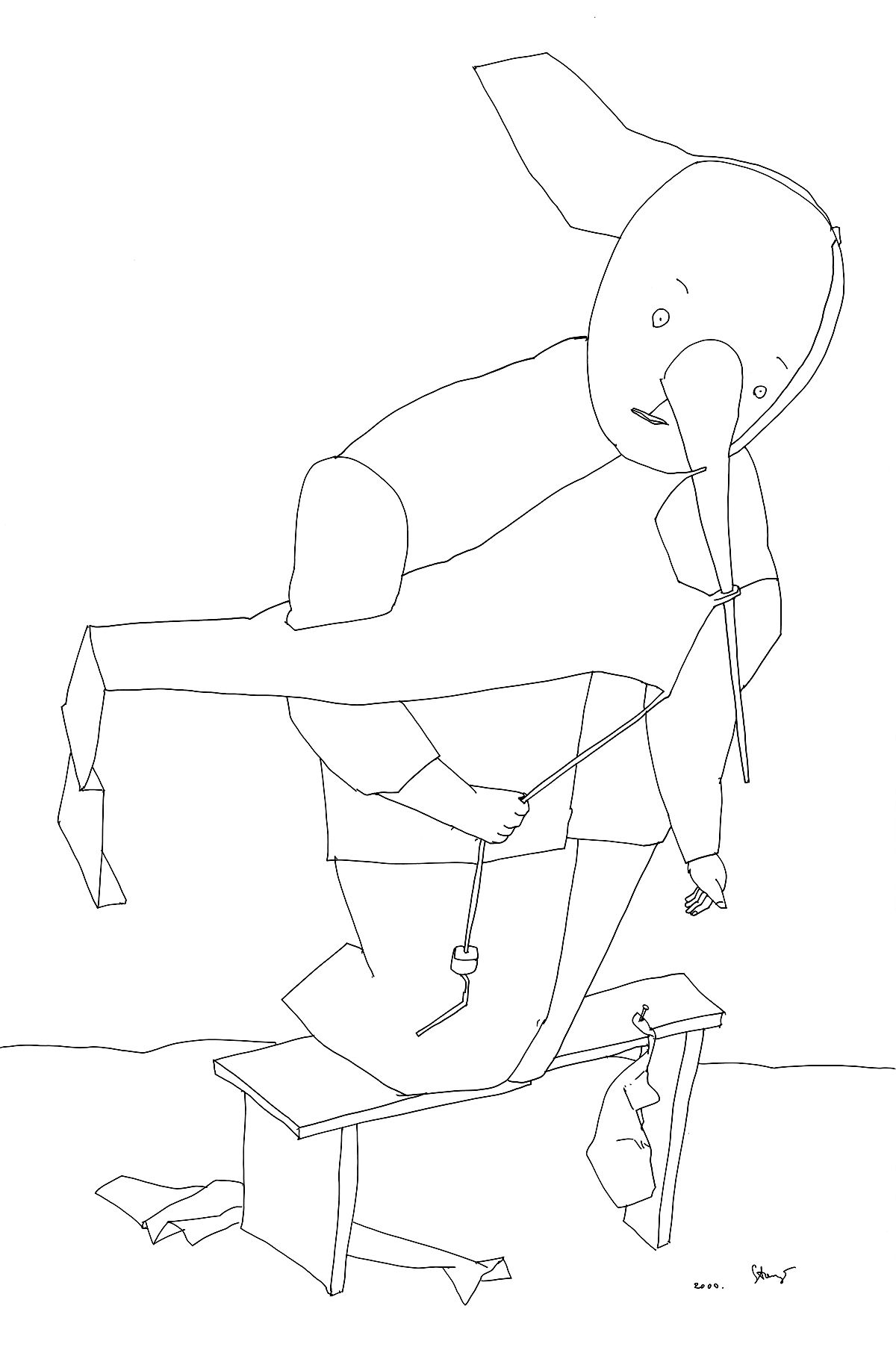
Theatre, paper, ink. 2000
-
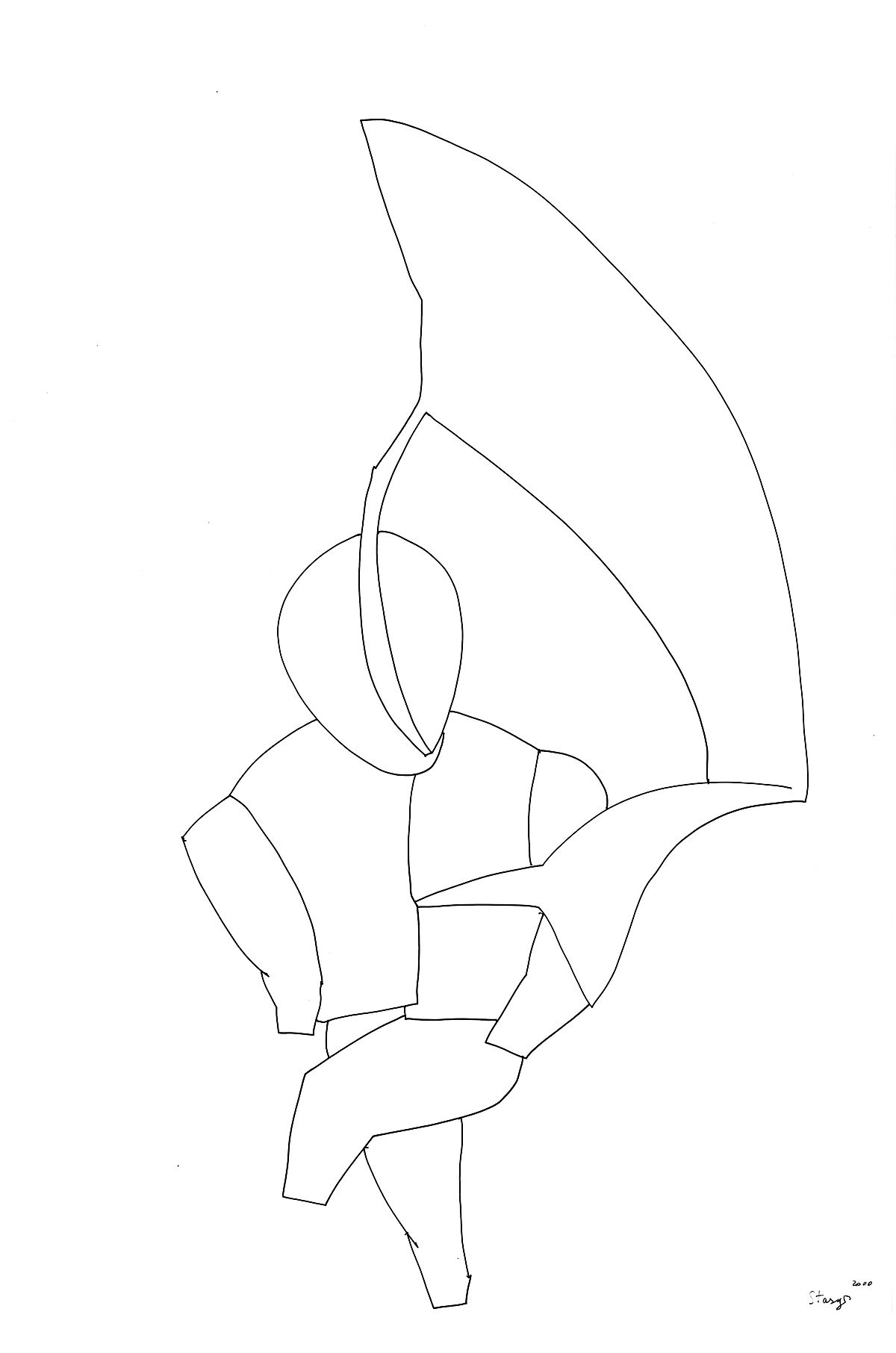
Expatri, paper, ink. 2000
-
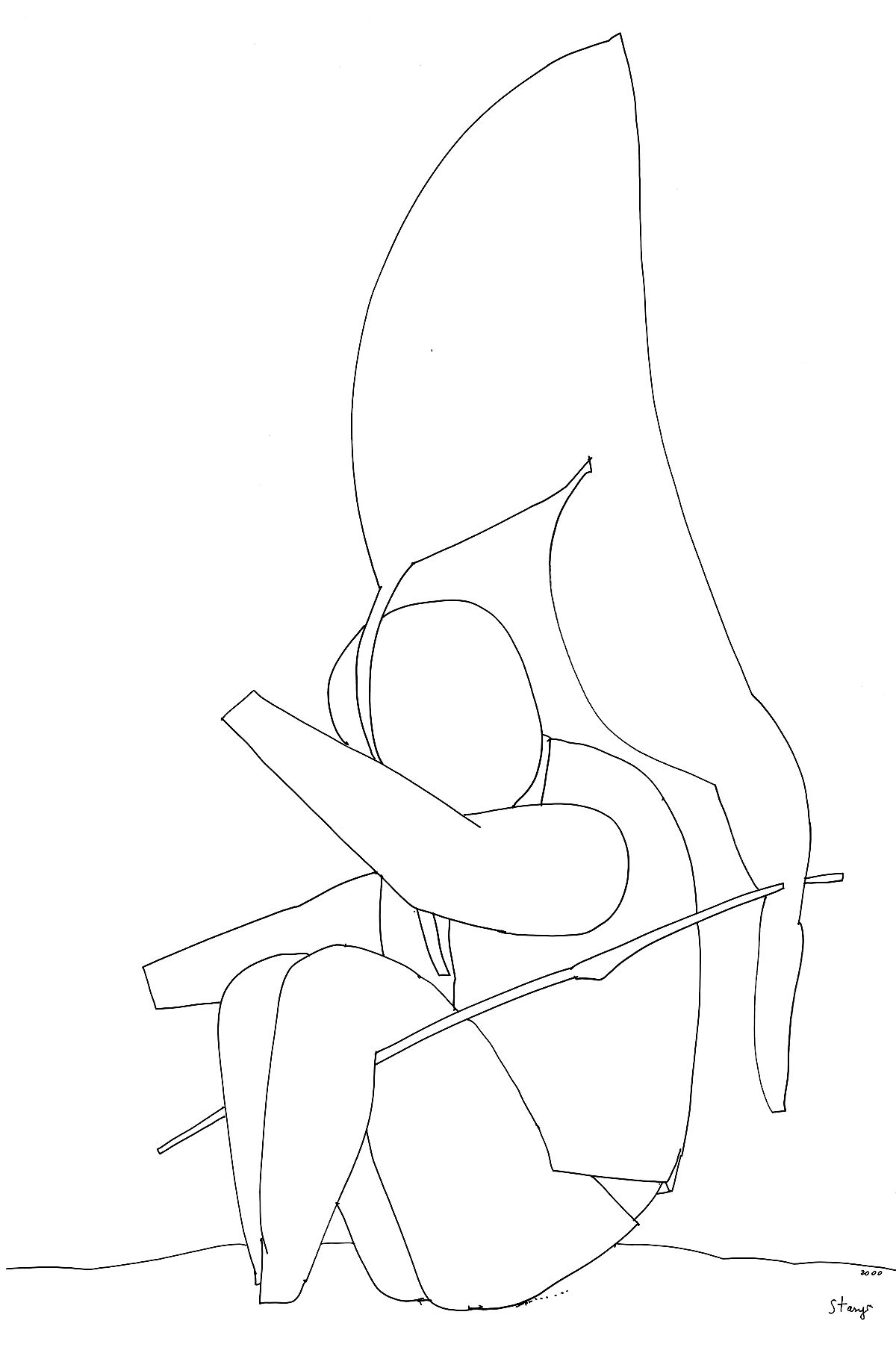
Shelter, paper, ink. 2000
-
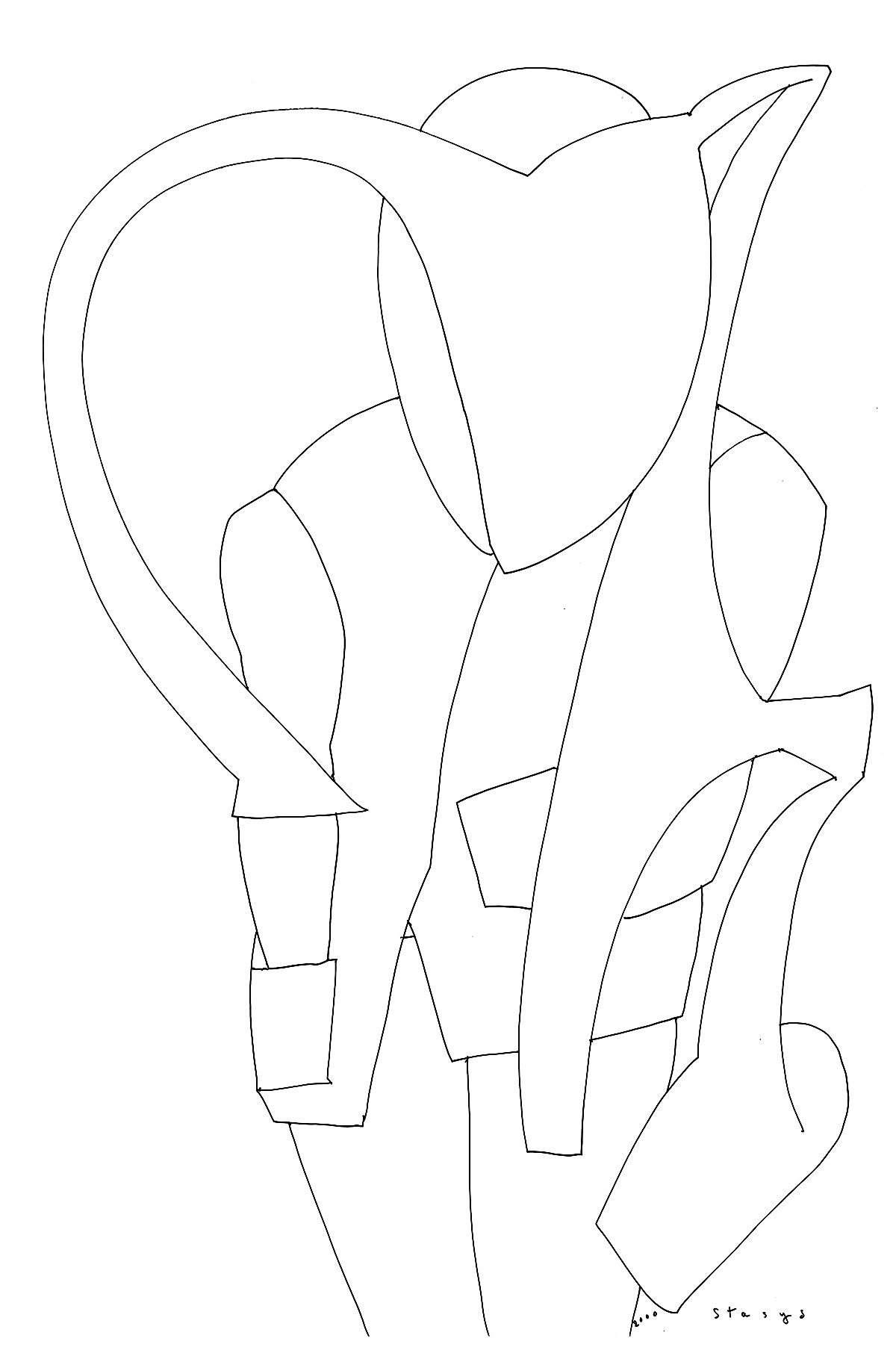
The Question, paper, ink. 2000
-
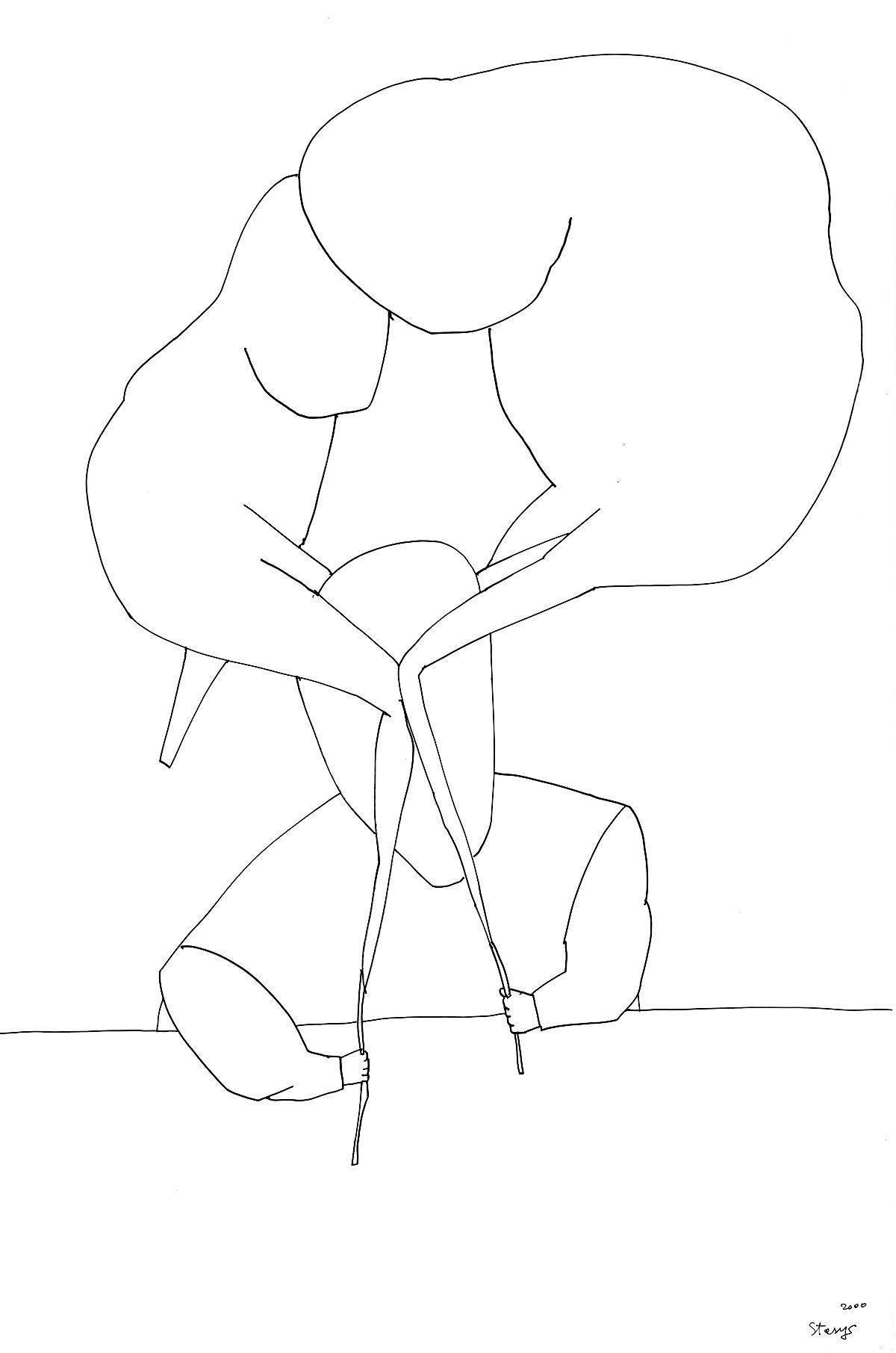
The Wing, paper, ink. 2000


